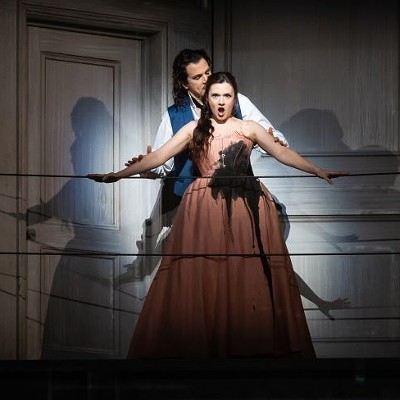Seldom has serendipity been more opportune than it is with the exhibition of 19th-century furniture from The Heritage Society, now at One Allen Center. The furniture is normally displayed in nearby Sam Houston Park, in the historic 1847 Kellum-Noble House, Houston's oldest surviving residence, which is being renovated. Instead of simply putting the furniture temporarily in storage, The Heritage Society and Arts Brookfield decided to put it on public display.
The furniture is shown here in a well-lit room on the second-floor lobby, and so offers even better chances for viewing than usual, as the historic house has a considerably darker interior.
Many of the pieces were hand-carved in the mid-19th century by German craftsmen, whose skill and dedication are clearly evident. Most striking was a walnut crib featuring spindles to protect the child from falling out, as well as spindles on the four corner legs. It clearly was designed to be decorative as well as functional, and serves both purposes admirably.
There is a magnificent four-poster bed, cedar and walnut, that seems to embody two very different aesthetic approaches. The headboard is ornamental, even perhaps whimsical, and is content to be simple and attractive. The four upright posters, on the other hand, seem to be more imposing than necessary, taller than required and thicker than one might expect. It is fit for a fortress, impenetrable, secure, protective against whatever might threaten the occupiers of the bed. At the risk of employing gender stereotypes, I speculated that the couple could not agree on design, so she was permitted the headboard, while he was granted the posts.
A tall wardrobe cabinet made of walnut is unusual in that no screws or nails were employed and for the fact that it can be taken apart and moved, then reassembled.
Perhaps the most interesting item is an 1860 love seat, distinctly designed to be beautiful, and succeeding. Its back is curved and, while it has no arms, the side frame still manages to be warm and seductive. While it is of course functional, its designer also wanted it to say, 'Look at me and admire." As a capper, it has a matching miniature footstool.
There is a pine and ash daybed, 78 inches long and 33 inches wide, and the ends have slight curves, as though heading toward a sleigh-bed flourish but stopping short because of innate modesty. The bed has the elegance of simplicity, as does a walnut dining-room table with six matching chairs, unpretentious but comfortable in the pleasing beauty of its shape and texture.
A large 1850 sofa with mahogany veneer and black horsehair upholstery includes a history of its use by Sam Houston. It seems stern, unforgiving, its back so upright as to echo a church pew. Its breadth is impressive, its arms large, and it is undeniably handsome, but seems to warn: "Be on your best behavior here."
One marble-top table is just so heavy and stolid that it would be difficult to call it attractive. It has a deep wooden mahogany veneer support for the marble, and four thick legs on wheels, but the entire structure seems too massive for a round table limited in size.
The joinings in many of the drawers and cabinets employ dovetailing, strong and attractive, and there's an unpretentious elegance to a number of these wooden items. There is a corner cupboard of walnut and cedar that looks enormously useful. An 1845 secretary desk/bookcase has inlaid leather and some folding capacity, and seems to be so attractive that it would almost distract from work.
There is a rocking chair (1842) that captures the mood of this exhibition, and a wool-winder device, hand-carved despite its complexity and moving parts.
A portrait of Sam Houston, done after his death, shows a handsome and strong leader, and the curators were helpful in pointing out that he had been governor of Tennessee before becoming president and then governor of Texas. Next to him is an even larger portrait of his mother-in-law, painted while she was alive, and it expresses vividly all that one might dread from this relationship. Her hand is pointing to a passage in a book, no doubt the Bible passage describing the specific particular lapse by Sam that she was calling attention to. I'm certain she had her own charm, but it's not present in this portrait.
There is more, much more, and a visitor is certain to find his or her own favorites. The exhibition provides a printed guide that lists each item, coded with a number, and there's a large illustration on one wall as well, so that navigating an exhibit this large is amazingly easy.
The exhibit is co-curated by Ginger Berni and Wallace Saage, and is somewhat unusual since it is on display from 11 a.m. to 2 p.m., Monday through Friday -- a curator or volunteer is always on hand.
Since the temperature must be kept lower than one might wish in order to protect the furniture, a sweater may come in handy. This is the kind of detailed exhibition that requires some study and contemplation, and provides rewards accordingly, so leaving adequate time to relish its variety and fascination is suggested.
Texas Treasures: Fine Furnishings from The Heritage Society's Kellum-Noble House Through December 31. Presented by Arts Brookfield and The Heritage Society, second-floor lobby, One Allen Center at 500 Dallas, 713-336-2280, artsbrookfield.com or heritagesociety.org.





